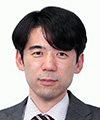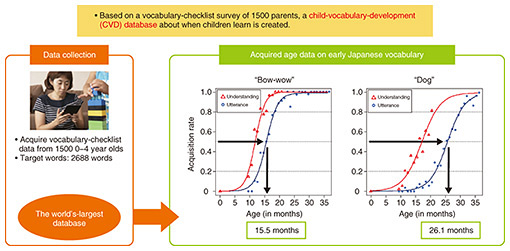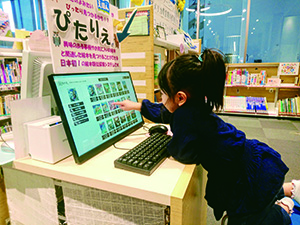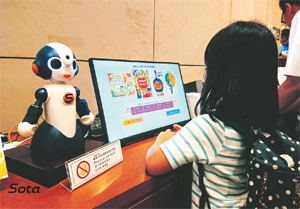 |
|||||||
|
|
|||||||
|
Front-line Researchers Vol. 18, No. 3, pp. 6–10, Mar. 2020. https://doi.org/10.53829/ntr202003fr1  In Life, Nothing Is Wasted. Let’s Build a Society in which Everyone Can Live an Active LifeOverviewA report published in August 2015 by the World Literacy Foundation estimates that economic and social loss due to illiteracy in Japan is about 95.1 billion yen annually [1]. Thanks to compulsory education, Japan is said to have achieved a literacy rate of 99.8%. However, according to a survey by the National Institute of Informatics conducted in 2016 [2], many junior- and senior-high-school students do not understand the structure of basic sentences, such as the relationship between subjects and predicates. We interviewed Tessei Kobayashi, a senior distinguished researcher at NTT Communication Science Laboratories, who is researching the development of the linguistic ability, which plays an important role in social participation, about his current research and attitude as a researcher. Keywords: child language development, early education, picture book Toward educational support based on evidence—Would you like to start by telling us about your current research? I’m researching the mechanism of child language acquisition and evidence-based educational support. Children generally learn the basics of their mother tongue during their first 3 years of childhood. I’m researching the mechanisms of speech perception, utterance, and learning of vocabulary, grammar, and letters involved in that learning process. English as a second language has recently been included in elementary schools in Japan, and this area has also been my research target. I’m also studying social cognition. Children are able to judge the feelings and emotions of others from around 3−5 years old, and I’m investigating the development of that ability in relation to language skills. The focus has been on both language acquisition and cognitive skills of typically developing children; however, I think that if the feeling/emotion-judgement mechanism is understood, it will be possible to understand the stumbling points concerning language acquisition in atypically developing children. My goal is to continue researching these topics in collaboration with medical institutions such as hospitals and provide evidence-based educational support. —It’s a combination of your wisdom and affection for children. Your research might help many parents in raising their children. So, specifically, what kind of research do you conduct? In one of my studies, namely, the mechanism by which Japanese vocabulary is acquired, not much basic data are available. Accordingly, we asked mothers of children aged up to 4 years to check what words their children can say at that stage. We then created statistical models to understand the initial development of language acquisition. Looking at the relationship between age and language acquisition from the collected data revealed that about 50% of infants at 15.5 months can say the word “wanwan” (Japanese “bow-wow”) when they see a dog, whereas they can say “inu” (“dog”) at 26.1 months. Moreover, the first word that infants can understand is their own name, and about 50% of infants can understand their name at about 7 months. We confirmed that in the next step of language acquisition infants understand words used for social communication such as “peekaboo” and “bye-bye” and by their first birthday, they can speak by understanding about 15 words on average. We thought that it would be useful if we could create a database of such data and use it to search for words according to age (in months and years) of infants and create content according to their age (Fig. 1). Based on such scientific findings, I’ve been supervising an educational television program for over 10 years. Evidence-based guidelines can now be added to the program production, which was conventionally based on years of experience and know-how.
We have also created picture books based on this database. A total of about 300,000 copies have been published in a series of five books. Although we created a picture book based only on words learnt at the earlier stages of language acquisition, the rate of language acquisition differs from child to child. Given that fact, we have been conducting field experiments with the aim of creating picture books personalized for individual children. That is, mothers are asked to check the vocabulary status of their children, and a picture book incorporating words learnt is created that is suitable for that child. Since this picture book was very popular among test participants, we started commercializing it in collaboration with NTT Printing in December 2019 and began test sales as four personalized educational picture books. Picture books significantly contribute to language acquisition, so this picture book represents an effort to support language acquisition. In general, as part of programs such as Bookstart, local governments distribute one picture book to parents when infant medical checkups start; however, it is difficult to get children into the habit of reading picture books by distributing only one book. To encourage parents and children to learn languages by making it a habit to read picture books, I thought it was important to motivate them to go to the library. In January 2020, in cooperation with the village of Onna in Okinawa, Japan, we began creating a personalized educational picture book for parents and their children who received a medical checkup to give children opportunities to go to the library. The personalized educational picture book is completed in about 10 days, so it is a mechanism for getting children to go back to the library to receive their books in an attempt to make it a habit to read picture books through repeated behavior, that is, if children are encouraged to return to the library many times, they can choose suitable picture books from the collection. We have also developed a system of searching for picture books—called Pitarie—that searches for picture books that match the interest and the developmental stage of individual children [3] (Fig. 2). Although a target age group is indicated on each picture book, the range is quite wide. Therefore, by (i) analyzing the target age presented on the picture book and the word and sentence data appearing in the picture book and (ii) estimating the complexity of the sentences by using academic data and natural language-processing technology, picture books can be retrieved based on a narrower range of age and readability. As well as the title, the words used in the picture book are sorted; however, in picture books, fonts are not in a fixed form and characters may overlap the pictures; thus, picture books cannot be read mechanically using optical character recognition, etc. Accordingly, 6000 picture books were manually input to this system. Note that there can be an error between the target age and actual vocabulary status of the child depending on the status of the child’s development. Therefore, the target age represents a guideline only. Nevertheless, I think that using Pitarie makes it possible to select suitable picture books for an individual child, and get children into the habit of going to libraries and reading picture books.
Pitarie has been commercialized by NTT DATA Kyushu, and in April 2019, it was officially introduced at the Fukui Prefectural Library. It was then officially installed at a nursery school in Shinagawa ward, Tokyo, and was very popular among the childcare staff. At an event called “Picture Book Museum” held during the summer break in Fukuoka City, a demonstration of recommending favorite picture books while interacting with a robot was held, and it was experienced by 20,000 people over almost two years (2018−2019) (Fig. 3). It was an experience that differed slightly from everyday life, so it was fun for the children. During the experience, the process of developing preferences for colors and patterns was analyzed. For example, in the case of a picture of a person on a book’s cover, it turned out that children like faces with big cartoon eyes, which differs from more artistic faces on books that adults want to read.
In the future, I’m thinking of analyzing child-growth records. With the cooperation of a nursery school and growth records regarding the vocabulary that children learned will be input by the staff into a special app, which could then recommend picture books suitable for a particular stage of a child’s growth. Although we already have the know-how, we are investigating ways to implement this without putting a burden on childcare staff. More recent studies in developmental psychology have shown that as the frequency that parents read picture books aloud to their children at the age of one or two increases, the reading comprehension and mathematical skills of third and fourth graders in elementary school (8–9 year olds) improves. With the hope that our research will help support this learning base, we have presenting our results throughout Japan. Ultimately, enthusiasm and motivation pave the way forward—How did this research get started? I think science is about explaining natural phenomena, and engineering is about creating things that we can use by referring to the explained phenomena. Humans speak in words, but animals do not. I wanted to find out why we can start to speak naturally after birth; that is, science was the trigger for my research. At university, I majored in psychology and became interested in human beings. In graduate school, I expanded my research to include the psychology of chimpanzees, elephants, and rats and investigated the mechanism of thinking and cognition in humans before they acquire language (a unique human characteristic) by comparing it with that in mammals. From that experience, I learned that humans are special among mammals because of traits such as our language ability, and I have come to explore our existence from an evolutionary and developmental perspective. Approaches to researching language vary widely. Even so, research on infants enables us to follow the process from knowing nothing up to learning a language; therefore, I thought it was important to be able to see the transitions of development and evolution. Many scientists find it interesting to take up the challenge of solving what has not been solved. I have the same feeling. When I faced an unsolvable problem, could not explain the analytical data as hypothesized, or could not understand the clues, I still thought that it was worthwhile and pushed on with my research. In general, basic research in science attempts to explain natural phenomena and presents results in papers. However, my current work has been expanded to the point at which such research results can be put to practical use after engaging in much discussion with various people. I’ve recently become very excited to handle the entirety of this process even though it is a small part of the NTT Group. I think this is not possible at research institutions such as universities. Originally, I was a scientist specializing in psychology and biology, so I was conducting research without being fully conscious of my contribution to society. However, because I’m working in a company, I think it is very rewarding to transition research accomplishments into businesses in collaboration with many colleagues and partners such as with Pitarie. —What is the motivation that supports your research activities? My motivation is twofold. The first is the feeling I get from the moment that I can understand the small things that I didn’t understand before, that is, the joy of understanding. The second is the joy of having someone apply my research results and realizing I made a contribution. It is up to researchers to decide what approach to take when they begin research, and I think it depends on their sense of determining which problem to solve. In my case, I took the problem of human language acquisition, and how to solve that problem also depends on the sense of the researcher. I want to—I need to—brush up this skill, so it is important to take on such challenges. However, there are times when we are asked questions such as “Does this mean anything?” Throughout the various stages of research and commercialization, people in various positions express differing opinions and concerns. In my experience, many of these opinions and concerns have been valid, which sometimes stopped me from doing what I tried to do. As you work on new research topics, getting people to understand them requires a great deal of effort. However, in any situation, it is important to push ahead with enthusiasm and confidence in what one really thinks is right. Rather than expecting someone to do something for you, it is necessary to take responsibility and have the willingness to do it all yourself until the very end, and this mindset is a source of motivation. Nothing is useless in life. Get involved with those around you and push ahead—Please say a few words to our researchers. After joining NTT, I was ordered to research a subject different from the specialized field that I was involved in as a student. Being able to stick to your specialty is very fortunate, but when you are not able to do that, which is often the case, turn what you are currently working on into something you like. Although my current research is completely different from that when I joined the company, I feel that my new specialty is interesting. Also, by stepping into engineering and business areas, I can realize that my research results are useful in society. When I wasn’t able to do what I wanted, I struggled through every day. I remember the head of the laboratory at that time saying, “There is nothing wasted in your life.” At that time, I thought it was just words of comfort, but now I realize it is true. Something seems to be useless at first glance, but by working on it and gaining experience, it can be very useful regarding my current research. As I mentioned earlier, it is important to have those who support you and get people around you to understand the significance of your research. Research and development is about creation and revealing new ideas; therefore, it can be difficult for others to understand. However, by patiently repeating explanations, you can gradually increase the number of people who understand your work and support you. By working with such people, you can produce concrete results. —How will you proceed in the future? I think it is my research style to set specific goals, go one step at a time, and achieve those goals. My team is currently conducting research on emotional development. I believe that knowledge of emotions, that is, thinking about and reading what others are feeling, is a very important ability in regard to children’s social life, so we are measuring this ability and investigating how to use it to support emotional development. In the near future, we plan to conduct a survey at several elementary schools. For example, if emotion is added to the word “Hello?”, the expression will vary in meaning. We will measure how well children understand such words. Mainly outside Japan, information on children having difficulty understanding speech is being gathered. With that in mind, I want to understand the actual situation in Japan and consider how to improve the capacity to understand speech. We still do not fully understand the learning process of writing and reading Japanese hiragana. Since the only large-scale study on this was conducted 50 years ago, we want to collect the latest data. In a previous study, we got children to write hiragana on paper, video-recorded it, and analyzed it; however, we can now measure writing order and speed by having children write hiragana on a tablet device that can automatically record and analyze such data. Analyzing typically developing children is more likely to lead to support for children with dyslexia. Studying child development revealed that a small stumble in the middle stages of development may reverberate later in life. I believe that if we find this stumble early on and provide support and training to address it, even if doing so does not lead to a fundamental solution, the child in question will be able to lead a fulfilling social life. I hope to continue supporting children so that they can have such a life. References
■Interviewee profileTessei KobayashiSenior Distinguished Researcher, Interaction Research Group, Innovative Communication Laboratory, NTT Communication Science Laboratories. He received a Ph.D. in psychology from the University of Tokyo in 2004. He is currently researching child language development, specifically vocabulary spurts and syntactic bootstrapping. |
|||||||











